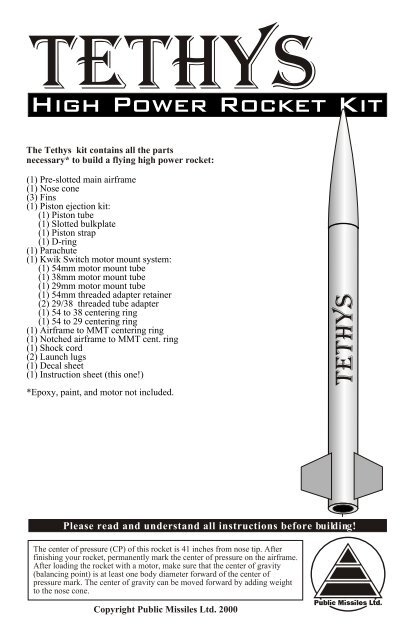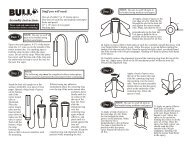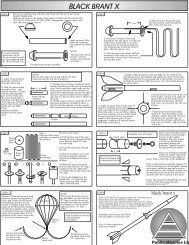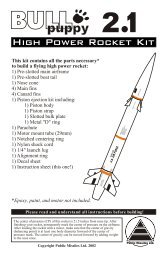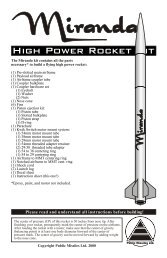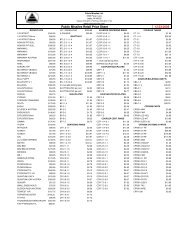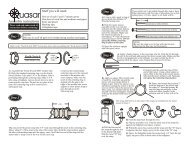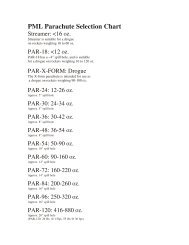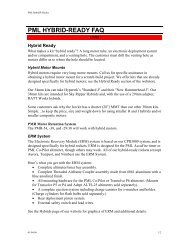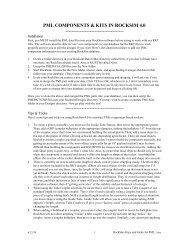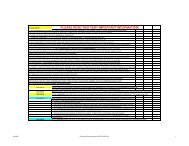Tethys instruction booklet.cdr - Public Missiles Ltd.
Tethys instruction booklet.cdr - Public Missiles Ltd.
Tethys instruction booklet.cdr - Public Missiles Ltd.
Create successful ePaper yourself
Turn your PDF publications into a flip-book with our unique Google optimized e-Paper software.
The <strong>Tethys</strong> kit contains all the parts<br />
necessary* to build a flying high power rocket:<br />
(1) Pre-slotted main airframe<br />
(1) Nose cone<br />
(3) Fins<br />
(1) Piston ejection kit:<br />
(1) Piston tube<br />
(1) Slotted bulkplate<br />
(1) Piston strap<br />
(1) D-ring<br />
(1) Parachute<br />
(1) Kwik Switch motor mount system:<br />
(1) 54mm motor mount tube<br />
(1) 38mm motor mount tube<br />
(1) 29mm motor mount tube<br />
(1) 54mm threaded adapter retainer<br />
(2) 29/38 threaded tube adapter<br />
(1) 54 to 38 centering ring<br />
(1) 54 to 29 centering ring<br />
(1) Airframe to MMT centering ring<br />
(1) Notched airframe to MMT cent. ring<br />
(1) Shock cord<br />
(2) Launch lugs<br />
(1) Decal sheet<br />
(1) Instruction sheet (this one!)<br />
*Epoxy, paint, and motor not included.<br />
Please read and understand all <strong>instruction</strong>s before building!<br />
The center of pressure (CP) of this rocket is 41 inches from nose tip. After<br />
finishing your rocket, permanently mark the center of pressure on the airframe.<br />
After loading the rocket with a motor, make sure that the center of gravity<br />
(balancing point) is at least one body diameter forward of the center of<br />
pressure mark. The center of gravity can be moved forward by adding weight<br />
to the nose cone.<br />
Copyright <strong>Public</strong> <strong>Missiles</strong> <strong>Ltd</strong>. 2000
Basic Construction FAQ<br />
The major parts involved in each step are shown shaded at the beginning of that<br />
step. Areas where epoxy should be applied are shown as well.<br />
PREP & ASSEMBLY<br />
( Read and understand the <strong>instruction</strong> steps fully before you begin the step.<br />
( ALWAYS sand the parts to be bonded with 100-120 grit sandpaper.<br />
( We strongly recommend you dry-fit (assemble without gluing) all parts in each step<br />
BEFORE epoxying them together. Sand or adjust fit as needed before gluing.<br />
( Most epoxies work fine. Use 5 or 15 minute depending on how quickly you feel you can<br />
complete the step. Use longer set-time epoxy if you're unsure.<br />
( To make internal fillets to the fins deep up into the airframe, "load up" the end of a dowel<br />
with a blob of epoxy, then stick the dowel into the airframe and onto the fin joint you're<br />
working on. After depositing enough epoxy in this fashion, you can pull the dowel toward<br />
you, making a fillet with the rounded edge of the dowel.<br />
( Be sure to follow the "Do's & Don'ts" sheet provided with QT tubing.<br />
( Fins do not need to be "shaped". Lightly sand the edges to remove any manufacturing burrs.<br />
PAINTING/FINISHING<br />
( Before you paint the fins, scuff the entire surface with 220 grit sandpaper. This is easiest to<br />
do before mounting the fins.<br />
( Plastic nosecone imperfections can be filled with plastic model kit putty.<br />
( Stay with the same brand of paint throughout the process; primer, base color, accent colors,<br />
and clear coat. DO NOT skimp on the "shake the can for at least two minutes after the ball<br />
rattles" step! For the best finish, let each coat dry overnight and sand lightly with 320 or<br />
400 grit sandpaper.<br />
( Apply the last color coat as heavy as possible without running or sagging. Let the paint cure<br />
for at least 48 hours before handling!<br />
( We recommend a clear coat of some sort to help protect the decals as well as "seal" their<br />
edges to help prevent them peeling off. When using any clear coat, put on only VERY thin,<br />
light coats, and wait at least 5 minutes between coats. The clear coat can damage your<br />
decals or paint if you put it on too heavily or don't wait long enough between coats!<br />
FINAL FITTING/PREPARATIONS FOR FLIGHT<br />
( The piston should be a smooth slip-fit in the airframe; this is critical. Sand the piston as<br />
needed so it can be easily inserted, and pulled out with just a gentle tug on the shock cord.<br />
Keep sandpaper in your range box in case you need to adjust the fit the first few times at<br />
the field to deal with differing temperature and humidity.<br />
( Couplers should also be sanded to allow easy separation of the rocket.<br />
( If the coupler or nosecone is too loose, use masking tape to build it up to a good fit. If the<br />
nosecone is too tight, sand the ribs on the shoulder until it fits well. The parts fit properly if<br />
the rocket can be held upside down and gently shaken with nothing moving or coming<br />
apart.<br />
( Ejections will leave a black, gritty residue inside the airframe. Occasionally wipe the tube<br />
interior with a damp cloth wrapped around a dowel or broomstick; allow to dry.<br />
( See our website FAQ for information about thrust rings and motor retention. Motor<br />
recommendation information is available on our website on the Specs Page.<br />
For our complete FAQ, see the FAQ Page on our website at www.publicmissiles.com.<br />
www.publicmissiles.com<br />
The PML Web Store and Knowledge Base
Other items you will need:<br />
> Masking tape<br />
> One set of epoxy<br />
><br />
Cellophane tape<br />
> One sheet each 120 and 220 sandpaper<br />
> Ruler and pencil<br />
Please read and understand all <strong>instruction</strong>s before continuing!<br />
All surfaces to be bonded must be scuffed with 120 grit sandpaper.<br />
Step 1<br />
Spread a bead of epoxy around the inside circuference of the<br />
54mm mother tube to a depth of about 1/2”<br />
54mm KS-2000<br />
Mother Tube<br />
0.5”<br />
With the threaded adapter retainer laying flat on the<br />
table, slowly lower the motor tube in place over the<br />
retainer using a back and forth twisting motion to<br />
spread the epoxy. Look down into the tube and make<br />
sure no epoxy runs onto the threads! If this occurs,<br />
remove the retainer immediately, wipe it clean and<br />
start again. Press the tube firmly over the retainer until<br />
it is in firm contact with the notched rib. Allow the<br />
epoxy to set.<br />
Twist motor tube<br />
back and forth<br />
while slowly<br />
setting in place<br />
Threaded adapter<br />
retainer<br />
Rib<br />
Notch in rib<br />
Step 2<br />
Dry fit both centering rings into the airframe and over the motor tube. The notched ring can be<br />
a little snug in the airframe and on the threaded adapter retainer. If it is tight, sand the ID<br />
and/or OD for a better fit. The standard centering ring should be a little looser in the airframe<br />
and over the motor mount tube to aid in later removal. Sand the ID and/or OD for a looser fit if<br />
necessary.<br />
Standard<br />
Notched<br />
centering ring<br />
Gap in epoxy<br />
centering ring<br />
Spread a bead of epoxy around the<br />
circumference of the threaded<br />
Motor tube assembly<br />
adapter retainer leaving a 1” gap in<br />
the bead at the notch in the rib. Slip<br />
the notched centering ring over the<br />
threaded adapter retainer with the<br />
Tape tabs<br />
Gap in epoxy fillet<br />
notch aligned with the gap in the<br />
epoxy bead. Be sure the notch in the<br />
ring remains clear of epoxy. Locate<br />
the ring against the rib and with the<br />
notches aligned. Allow the epoxy to<br />
set.<br />
Slide the standard centering ring over the motor tube until 1/8" of the motor tube is protruding<br />
beyond the ring. Make 3 or 4 tabs using cellophane tape as shown above to aid in removing<br />
this ring later. Do not use any glue at this time, this centering ring will be removed in a<br />
subsequent step.
Step 3<br />
Step 4<br />
Step 3<br />
Step 4<br />
Step 3<br />
Step 4<br />
Step 3<br />
Step 4<br />
Step 3<br />
Step 4<br />
Step 3<br />
Step 4<br />
Step 3<br />
Step 4<br />
Step 3<br />
Step 4<br />
Step 3<br />
Step 4<br />
Step 3<br />
Step 4<br />
Step 3<br />
Step 4<br />
Step 3<br />
Step 4<br />
Step 3<br />
Step 4<br />
Step 3<br />
Step 4<br />
Spread a layer of epoxy about 1” wide<br />
and 4” long on the motor tube just<br />
below the notch in the upper centering<br />
ring. Slip one end of the piston strap<br />
(the widest strap in the kit) through the<br />
notch in the centering ring. Pull<br />
through about 4" of this strap through<br />
the notch and press it firmly into the<br />
epoxy on the side of the motor tube.<br />
Hold the strap in place against the tube<br />
with masking tape until the epoxy<br />
cures. Remove the masking tape. Fill<br />
the entire centering ring notch with<br />
epoxy. Stuff the free end of the strap<br />
into the motor tube to keep it out of the<br />
way for the next step.<br />
~4.0”<br />
Notch<br />
Piston strap<br />
Masking tape<br />
Fill notch<br />
completely<br />
with epoxy<br />
Epoxy<br />
Step 3<br />
Step 4<br />
Spread a layer of epoxy about 1” wide<br />
and 4” long on the motor tube just<br />
below the notch in the upper centering<br />
ring. Slip one end of the piston strap<br />
(the widest strap in the kit) through the<br />
notch in the centering ring. Pull<br />
through about 4" of this strap through<br />
the notch and press it firmly into the<br />
epoxy on the side of the motor tube.<br />
Hold the strap in place against the tube<br />
with masking tape until the epoxy<br />
cures. Remove the masking tape. Fill<br />
the entire centering ring notch with<br />
epoxy. Stuff the free end of the strap<br />
into the motor tube to keep it out of the<br />
way for the next step.<br />
~4.0”<br />
Notch<br />
Piston strap<br />
Masking tape<br />
Fill notch<br />
completely<br />
with epoxy<br />
Epoxy<br />
You will need a long stick or dowel for applying epoxy in this step. Just below is a drawing of<br />
one good method for creating an extended epoxy applicator. Simply epoxy a dowel or stick to<br />
a tongue depressor or popsicle stick.<br />
Make a mark on the stick at<br />
so you can tell how deep the stick is in the airframe when<br />
spreading the epoxy.<br />
13”<br />
13”<br />
Using your extended epoxy applicator, spread a bead of epoxy around the<br />
inside circumference of the airframe<br />
from the bottom of the airframe.<br />
Holding the airframe upright (vertical), push the motor tube assembly into the<br />
airframe, making sure the strap is NOT in line with a fin slot, until the<br />
bottom of the motor tube is flush with the bottom of the airframe. Keep the<br />
assembly vertical until the epoxy cures.<br />
13.0”<br />
13.0”<br />
Mark the stick<br />
at 13”<br />
Keep the mark<br />
on the stick<br />
even with the<br />
end of the<br />
airframe<br />
Motor tube<br />
flush with<br />
airframe<br />
Strap on motor<br />
tube NOT<br />
in line with<br />
a fin slot<br />
Step 3<br />
Step 4<br />
Spread a layer of epoxy about 1” wide<br />
and 4” long on the motor tube just<br />
below the notch in the upper centering<br />
ring. Slip one end of the piston strap<br />
(the widest strap in the kit) through the<br />
notch in the centering ring. Pull<br />
through about 4" of this strap through<br />
the notch and press it firmly into the<br />
epoxy on the side of the motor tube.<br />
Hold the strap in place against the tube<br />
with masking tape until the epoxy<br />
cures. Remove the masking tape. Fill<br />
the entire centering ring notch with<br />
epoxy. Stuff the free end of the strap<br />
into the motor tube to keep it out of the<br />
way for the next step.<br />
~4.0”<br />
Notch<br />
Piston strap<br />
Masking tape<br />
Fill notch<br />
completely<br />
with epoxy<br />
Epoxy<br />
You will need a long stick or dowel for applying epoxy in this step. Just below is a drawing of<br />
one good method for creating an extended epoxy applicator. Simply epoxy a dowel or stick to<br />
a tongue depressor or popsicle stick.<br />
Make a mark on the stick at<br />
so you can tell how deep the stick is in the airframe when<br />
spreading the epoxy.<br />
13”<br />
13”<br />
Using your extended epoxy applicator, spread a bead of epoxy around the<br />
inside circumference of the airframe<br />
from the bottom of the airframe.<br />
Holding the airframe upright (vertical), push the motor tube assembly into the<br />
airframe, making sure the strap is NOT in line with a fin slot, until the<br />
bottom of the motor tube is flush with the bottom of the airframe. Keep the<br />
assembly vertical until the epoxy cures.<br />
13.0”<br />
13.0”<br />
Mark the stick<br />
at 13”<br />
Keep the mark<br />
on the stick<br />
even with the<br />
end of the<br />
airframe<br />
Motor tube<br />
flush with<br />
airframe<br />
Strap on motor<br />
tube NOT<br />
in line with<br />
a fin slot<br />
Step 3<br />
Step 4<br />
Spread a layer of epoxy about 1” wide<br />
and 4” long on the motor tube just<br />
below the notch in the upper centering<br />
ring. Slip one end of the piston strap<br />
(the widest strap in the kit) through the<br />
notch in the centering ring. Pull<br />
through about 4" of this strap through<br />
the notch and press it firmly into the<br />
epoxy on the side of the motor tube.<br />
Hold the strap in place against the tube<br />
with masking tape until the epoxy<br />
cures. Remove the masking tape. Fill<br />
the entire centering ring notch with<br />
epoxy. Stuff the free end of the strap<br />
into the motor tube to keep it out of the<br />
way for the next step.<br />
~4.0”<br />
Notch<br />
Piston strap<br />
Masking tape<br />
Fill notch<br />
completely<br />
with epoxy<br />
Epoxy<br />
You will need a long stick or dowel for applying epoxy in this step. Just below is a drawing of<br />
one good method for creating an extended epoxy applicator. Simply epoxy a dowel or stick to<br />
a tongue depressor or popsicle stick.<br />
Make a mark on the stick at<br />
so you can tell how deep the stick is in the airframe when<br />
spreading the epoxy.<br />
13”<br />
13”<br />
Using your extended epoxy applicator, spread a bead of epoxy around the<br />
inside circumference of the airframe<br />
from the bottom of the airframe.<br />
Holding the airframe upright (vertical), push the motor tube assembly into the<br />
airframe, making sure the strap is NOT in line with a fin slot, until the<br />
bottom of the motor tube is flush with the bottom of the airframe. Keep the<br />
assembly vertical until the epoxy cures.<br />
13.0”<br />
13.0”<br />
Mark the stick<br />
at 13”<br />
Keep the mark<br />
on the stick<br />
even with the<br />
end of the<br />
airframe<br />
Motor tube<br />
flush with<br />
airframe<br />
Strap on motor<br />
tube NOT<br />
in line with<br />
a fin slot<br />
Step 3<br />
Step 4<br />
Spread a layer of epoxy about 1” wide<br />
and 4” long on the motor tube just<br />
below the notch in the upper centering<br />
ring. Slip one end of the piston strap<br />
(the widest strap in the kit) through the<br />
notch in the centering ring. Pull<br />
through about 4" of this strap through<br />
the notch and press it firmly into the<br />
epoxy on the side of the motor tube.<br />
Hold the strap in place against the tube<br />
with masking tape until the epoxy<br />
cures. Remove the masking tape. Fill<br />
the entire centering ring notch with<br />
epoxy. Stuff the free end of the strap<br />
into the motor tube to keep it out of the<br />
way for the next step.<br />
~4.0”<br />
Notch<br />
Piston strap<br />
Masking tape<br />
Fill notch<br />
completely<br />
with epoxy<br />
Epoxy<br />
You will need a long stick or dowel for applying epoxy in this step. Just below is a drawing of<br />
one good method for creating an extended epoxy applicator. Simply epoxy a dowel or stick to<br />
a tongue depressor or popsicle stick.<br />
Make a mark on the stick at<br />
so you can tell how deep the stick is in the airframe when<br />
spreading the epoxy.<br />
13”<br />
13”<br />
Using your extended epoxy applicator, spread a bead of epoxy around the<br />
inside circumference of the airframe<br />
from the bottom of the airframe.<br />
Holding the airframe upright (vertical), push the motor tube assembly into the<br />
airframe, making sure the strap is NOT in line with a fin slot, until the<br />
bottom of the motor tube is flush with the bottom of the airframe. Keep the<br />
assembly vertical until the epoxy cures.<br />
13.0”<br />
13.0”<br />
Mark the stick<br />
at 13”<br />
Keep the mark<br />
on the stick<br />
even with the<br />
end of the<br />
airframe<br />
Motor tube<br />
flush with<br />
airframe<br />
Strap on motor<br />
tube NOT<br />
in line with<br />
a fin slot<br />
Step 3<br />
Step 4<br />
Spread a layer of epoxy about 1” wide<br />
and 4” long on the motor tube just<br />
below the notch in the upper centering<br />
ring. Slip one end of the piston strap<br />
(the widest strap in the kit) through the<br />
notch in the centering ring. Pull<br />
through about 4" of this strap through<br />
the notch and press it firmly into the<br />
epoxy on the side of the motor tube.<br />
Hold the strap in place against the tube<br />
with masking tape until the epoxy<br />
cures. Remove the masking tape. Fill<br />
the entire centering ring notch with<br />
epoxy. Stuff the free end of the strap<br />
into the motor tube to keep it out of the<br />
way for the next step.<br />
~4.0”<br />
Notch<br />
Piston strap<br />
Masking tape<br />
Fill notch<br />
completely<br />
with epoxy<br />
Epoxy<br />
You will need a long stick or dowel for applying epoxy in this step. Just below is a drawing of<br />
one good method for creating an extended epoxy applicator. Simply epoxy a dowel or stick to<br />
a tongue depressor or popsicle stick.<br />
Make a mark on the stick at<br />
so you can tell how deep the stick is in the airframe when<br />
spreading the epoxy.<br />
13”<br />
13”<br />
Using your extended epoxy applicator, spread a bead of epoxy around the<br />
inside circumference of the airframe<br />
from the bottom of the airframe.<br />
Holding the airframe upright (vertical), push the motor tube assembly into the<br />
airframe, making sure the strap is NOT in line with a fin slot, until the<br />
bottom of the motor tube is flush with the bottom of the airframe. Keep the<br />
assembly vertical until the epoxy cures.<br />
13.0”<br />
13.0”<br />
Mark the stick<br />
at 13”<br />
Keep the mark<br />
on the stick<br />
even with the<br />
end of the<br />
airframe<br />
Motor tube<br />
flush with<br />
airframe<br />
Strap on motor<br />
tube NOT<br />
in line with<br />
a fin slot<br />
Step 3<br />
Step 4<br />
Spread a layer of epoxy about 1” wide<br />
and 4” long on the motor tube just<br />
below the notch in the upper centering<br />
ring. Slip one end of the piston strap<br />
(the widest strap in the kit) through the<br />
notch in the centering ring. Pull<br />
through about 4" of this strap through<br />
the notch and press it firmly into the<br />
epoxy on the side of the motor tube.<br />
Hold the strap in place against the tube<br />
with masking tape until the epoxy<br />
cures. Remove the masking tape. Fill<br />
the entire centering ring notch with<br />
epoxy. Stuff the free end of the strap<br />
into the motor tube to keep it out of the<br />
way for the next step.<br />
~4.0”<br />
Notch<br />
Piston strap<br />
Masking tape<br />
Fill notch<br />
completely<br />
with epoxy<br />
Epoxy<br />
You will need a long stick or dowel for applying epoxy in this step. Just below is a drawing of<br />
one good method for creating an extended epoxy applicator. Simply epoxy a dowel or stick to<br />
a tongue depressor or popsicle stick.<br />
Make a mark on the stick at<br />
so you can tell how deep the stick is in the airframe when<br />
spreading the epoxy.<br />
13”<br />
13”<br />
Using your extended epoxy applicator, spread a bead of epoxy around the<br />
inside circumference of the airframe<br />
from the bottom of the airframe.<br />
Holding the airframe upright (vertical), push the motor tube assembly into the<br />
airframe, making sure the strap is NOT in line with a fin slot, until the<br />
bottom of the motor tube is flush with the bottom of the airframe. Keep the<br />
assembly vertical until the epoxy cures.<br />
13.0”<br />
13.0”<br />
Mark the stick<br />
at 13”<br />
Keep the mark<br />
on the stick<br />
even with the<br />
end of the<br />
airframe<br />
Motor tube<br />
flush with<br />
airframe<br />
Strap on motor<br />
tube NOT<br />
in line with<br />
a fin slot<br />
Step 3<br />
Step 4<br />
Spread a layer of epoxy about 1” wide<br />
and 4” long on the motor tube just<br />
below the notch in the upper centering<br />
ring. Slip one end of the piston strap<br />
(the widest strap in the kit) through the<br />
notch in the centering ring. Pull<br />
through about 4" of this strap through<br />
the notch and press it firmly into the<br />
epoxy on the side of the motor tube.<br />
Hold the strap in place against the tube<br />
with masking tape until the epoxy<br />
cures. Remove the masking tape. Fill<br />
the entire centering ring notch with<br />
epoxy. Stuff the free end of the strap<br />
into the motor tube to keep it out of the<br />
way for the next step.<br />
~4.0”<br />
Notch<br />
Piston strap<br />
Masking tape<br />
Fill notch<br />
completely<br />
with epoxy<br />
Epoxy<br />
You will need a long stick or dowel for applying epoxy in this step. Just below is a drawing of<br />
one good method for creating an extended epoxy applicator. Simply epoxy a dowel or stick to<br />
a tongue depressor or popsicle stick.<br />
Make a mark on the stick at<br />
so you can tell how deep the stick is in the airframe when<br />
spreading the epoxy.<br />
13”<br />
13”<br />
Using your extended epoxy applicator, spread a bead of epoxy around the<br />
inside circumference of the airframe<br />
from the bottom of the airframe.<br />
Holding the airframe upright (vertical), push the motor tube assembly into the<br />
airframe, making sure the strap is NOT in line with a fin slot, until the<br />
bottom of the motor tube is flush with the bottom of the airframe. Keep the<br />
assembly vertical until the epoxy cures.<br />
13.0”<br />
13.0”<br />
Mark the stick<br />
at 13”<br />
Keep the mark<br />
on the stick<br />
even with the<br />
end of the<br />
airframe<br />
Motor tube<br />
flush with<br />
airframe<br />
Strap on motor<br />
tube NOT<br />
in line with<br />
a fin slot<br />
Step 3<br />
Step 4<br />
Spread a layer of epoxy about 1” wide<br />
and 4” long on the motor tube just<br />
below the notch in the upper centering<br />
ring. Slip one end of the piston strap<br />
(the widest strap in the kit) through the<br />
notch in the centering ring. Pull<br />
through about 4" of this strap through<br />
the notch and press it firmly into the<br />
epoxy on the side of the motor tube.<br />
Hold the strap in place against the tube<br />
with masking tape until the epoxy<br />
cures. Remove the masking tape. Fill<br />
the entire centering ring notch with<br />
epoxy. Stuff the free end of the strap<br />
into the motor tube to keep it out of the<br />
way for the next step.<br />
~4.0”<br />
Notch<br />
Piston strap<br />
Masking tape<br />
Fill notch<br />
completely<br />
with epoxy<br />
Epoxy<br />
You will need a long stick or dowel for applying epoxy in this step. Just below is a drawing of<br />
one good method for creating an extended epoxy applicator. Simply epoxy a dowel or stick to<br />
a tongue depressor or popsicle stick.<br />
Make a mark on the stick at<br />
so you can tell how deep the stick is in the airframe when<br />
spreading the epoxy.<br />
13”<br />
13”<br />
Using your extended epoxy applicator, spread a bead of epoxy around the<br />
inside circumference of the airframe<br />
from the bottom of the airframe.<br />
Holding the airframe upright (vertical), push the motor tube assembly into the<br />
airframe, making sure the strap is NOT in line with a fin slot, until the<br />
bottom of the motor tube is flush with the bottom of the airframe. Keep the<br />
assembly vertical until the epoxy cures.<br />
13.0”<br />
13.0”<br />
Mark the stick<br />
at 13”<br />
Keep the mark<br />
on the stick<br />
even with the<br />
end of the<br />
airframe<br />
Motor tube<br />
flush with<br />
airframe<br />
Strap on motor<br />
tube NOT<br />
in line with<br />
a fin slot<br />
Step 3<br />
Step 4<br />
Spread a layer of epoxy about 1” wide<br />
and 4” long on the motor tube just<br />
below the notch in the upper centering<br />
ring. Slip one end of the piston strap<br />
(the widest strap in the kit) through the<br />
notch in the centering ring. Pull<br />
through about 4" of this strap through<br />
the notch and press it firmly into the<br />
epoxy on the side of the motor tube.<br />
Hold the strap in place against the tube<br />
with masking tape until the epoxy<br />
cures. Remove the masking tape. Fill<br />
the entire centering ring notch with<br />
epoxy. Stuff the free end of the strap<br />
into the motor tube to keep it out of the<br />
way for the next step.<br />
~4.0”<br />
Notch<br />
Piston strap<br />
Masking tape<br />
Fill notch<br />
completely<br />
with epoxy<br />
Epoxy<br />
You will need a long stick or dowel for applying epoxy in this step. Just below is a drawing of<br />
one good method for creating an extended epoxy applicator. Simply epoxy a dowel or stick to<br />
a tongue depressor or popsicle stick.<br />
Make a mark on the stick at<br />
so you can tell how deep the stick is in the airframe when<br />
spreading the epoxy.<br />
13”<br />
13”<br />
Using your extended epoxy applicator, spread a bead of epoxy around the<br />
inside circumference of the airframe<br />
from the bottom of the airframe.<br />
Holding the airframe upright (vertical), push the motor tube assembly into the<br />
airframe, making sure the strap is NOT in line with a fin slot, until the<br />
bottom of the motor tube is flush with the bottom of the airframe. Keep the<br />
assembly vertical until the epoxy cures.<br />
13.0”<br />
13.0”<br />
Mark the stick<br />
at 13”<br />
Keep the mark<br />
on the stick<br />
even with the<br />
end of the<br />
airframe<br />
Motor tube<br />
flush with<br />
airframe<br />
Strap on motor<br />
tube NOT<br />
in line with<br />
a fin slot<br />
Step 3<br />
Step 4<br />
Spread a layer of epoxy about 1” wide<br />
and 4” long on the motor tube just<br />
below the notch in the upper centering<br />
ring. Slip one end of the piston strap<br />
(the widest strap in the kit) through the<br />
notch in the centering ring. Pull<br />
through about 4" of this strap through<br />
the notch and press it firmly into the<br />
epoxy on the side of the motor tube.<br />
Hold the strap in place against the tube<br />
with masking tape until the epoxy<br />
cures. Remove the masking tape. Fill<br />
the entire centering ring notch with<br />
epoxy. Stuff the free end of the strap<br />
into the motor tube to keep it out of the<br />
way for the next step.<br />
~4.0”<br />
Notch<br />
Piston strap<br />
Masking tape<br />
Fill notch<br />
completely<br />
with epoxy<br />
Epoxy<br />
You will need a long stick or dowel for applying epoxy in this step. Just below is a drawing of<br />
one good method for creating an extended epoxy applicator. Simply epoxy a dowel or stick to<br />
a tongue depressor or popsicle stick.<br />
Make a mark on the stick at<br />
so you can tell how deep the stick is in the airframe when<br />
spreading the epoxy.<br />
13”<br />
13”<br />
Using your extended epoxy applicator, spread a bead of epoxy around the<br />
inside circumference of the airframe<br />
from the bottom of the airframe.<br />
Holding the airframe upright (vertical), push the motor tube assembly into the<br />
airframe, making sure the strap is NOT in line with a fin slot, until the<br />
bottom of the motor tube is flush with the bottom of the airframe. Keep the<br />
assembly vertical until the epoxy cures.<br />
13.0”<br />
13.0”<br />
Mark the stick<br />
at 13”<br />
Keep the mark<br />
on the stick<br />
even with the<br />
end of the<br />
airframe<br />
Motor tube<br />
flush with<br />
airframe<br />
Strap on motor<br />
tube NOT<br />
in line with<br />
a fin slot<br />
Step 3<br />
Step 4<br />
Spread a layer of epoxy about 1” wide<br />
and 4” long on the motor tube just<br />
below the notch in the upper centering<br />
ring. Slip one end of the piston strap<br />
(the widest strap in the kit) through the<br />
notch in the centering ring. Pull<br />
through about 4" of this strap through<br />
the notch and press it firmly into the<br />
epoxy on the side of the motor tube.<br />
Hold the strap in place against the tube<br />
with masking tape until the epoxy<br />
cures. Remove the masking tape. Fill<br />
the entire centering ring notch with<br />
epoxy. Stuff the free end of the strap<br />
into the motor tube to keep it out of the<br />
way for the next step.<br />
~4.0”<br />
Notch<br />
Piston strap<br />
Masking tape<br />
Fill notch<br />
completely<br />
with epoxy<br />
Epoxy<br />
You will need a long stick or dowel for applying epoxy in this step. Just below is a drawing of<br />
one good method for creating an extended epoxy applicator. Simply epoxy a dowel or stick to<br />
a tongue depressor or popsicle stick.<br />
Make a mark on the stick at<br />
so you can tell how deep the stick is in the airframe when<br />
spreading the epoxy.<br />
13”<br />
13”<br />
Using your extended epoxy applicator, spread a bead of epoxy around the<br />
inside circumference of the airframe<br />
from the bottom of the airframe.<br />
Holding the airframe upright (vertical), push the motor tube assembly into the<br />
airframe, making sure the strap is NOT in line with a fin slot, until the<br />
bottom of the motor tube is flush with the bottom of the airframe. Keep the<br />
assembly vertical until the epoxy cures.<br />
13.0”<br />
13.0”<br />
Mark the stick<br />
at 13”<br />
Keep the mark<br />
on the stick<br />
even with the<br />
end of the<br />
airframe<br />
Motor tube<br />
flush with<br />
airframe<br />
Strap on motor<br />
tube NOT<br />
in line with<br />
a fin slot<br />
Step 3<br />
Step 4<br />
Spread a layer of epoxy about 1” wide<br />
and 4” long on the motor tube just<br />
below the notch in the upper centering<br />
ring. Slip one end of the piston strap<br />
(the widest strap in the kit) through the<br />
notch in the centering ring. Pull<br />
through about 4" of this strap through<br />
the notch and press it firmly into the<br />
epoxy on the side of the motor tube.<br />
Hold the strap in place against the tube<br />
with masking tape until the epoxy<br />
cures. Remove the masking tape. Fill<br />
the entire centering ring notch with<br />
epoxy. Stuff the free end of the strap<br />
into the motor tube to keep it out of the<br />
way for the next step.<br />
~4.0”<br />
Notch<br />
Piston strap<br />
Masking tape<br />
Fill notch<br />
completely<br />
with epoxy<br />
Epoxy<br />
You will need a long stick or dowel for applying epoxy in this step. Just below is a drawing of<br />
one good method for creating an extended epoxy applicator. Simply epoxy a dowel or stick to<br />
a tongue depressor or popsicle stick.<br />
Make a mark on the stick at<br />
so you can tell how deep the stick is in the airframe when<br />
spreading the epoxy.<br />
13”<br />
13”<br />
Using your extended epoxy applicator, spread a bead of epoxy around the<br />
inside circumference of the airframe<br />
from the bottom of the airframe.<br />
Holding the airframe upright (vertical), push the motor tube assembly into the<br />
airframe, making sure the strap is NOT in line with a fin slot, until the<br />
bottom of the motor tube is flush with the bottom of the airframe. Keep the<br />
assembly vertical until the epoxy cures.<br />
13.0”<br />
13.0”<br />
Mark the stick<br />
at 13”<br />
Keep the mark<br />
on the stick<br />
even with the<br />
end of the<br />
airframe<br />
Motor tube<br />
flush with<br />
airframe<br />
Strap on motor<br />
tube NOT<br />
in line with<br />
a fin slot<br />
Step 3<br />
Step 4<br />
Spread a layer of epoxy about 1” wide<br />
and 4” long on the motor tube just<br />
below the notch in the upper centering<br />
ring. Slip one end of the piston strap<br />
(the widest strap in the kit) through the<br />
notch in the centering ring. Pull<br />
through about 4" of this strap through<br />
the notch and press it firmly into the<br />
epoxy on the side of the motor tube.<br />
Hold the strap in place against the tube<br />
with masking tape until the epoxy<br />
cures. Remove the masking tape. Fill<br />
the entire centering ring notch with<br />
epoxy. Stuff the free end of the strap<br />
into the motor tube to keep it out of the<br />
way for the next step.<br />
~4.0”<br />
Notch<br />
Piston strap<br />
Masking tape<br />
Fill notch<br />
completely<br />
with epoxy<br />
Epoxy<br />
You will need a long stick or dowel for applying epoxy in this step. Just below is a drawing of<br />
one good method for creating an extended epoxy applicator. Simply epoxy a dowel or stick to<br />
a tongue depressor or popsicle stick.<br />
Make a mark on the stick at<br />
so you can tell how deep the stick is in the airframe when<br />
spreading the epoxy.<br />
13”<br />
13”<br />
Using your extended epoxy applicator, spread a bead of epoxy around the<br />
inside circumference of the airframe<br />
from the bottom of the airframe.<br />
Holding the airframe upright (vertical), push the motor tube assembly into the<br />
airframe, making sure the strap is NOT in line with a fin slot, until the<br />
bottom of the motor tube is flush with the bottom of the airframe. Keep the<br />
assembly vertical until the epoxy cures.<br />
13.0”<br />
13.0”<br />
Mark the stick<br />
at 13”<br />
Keep the mark<br />
on the stick<br />
even with the<br />
end of the<br />
airframe<br />
Motor tube<br />
flush with<br />
airframe<br />
Strap on motor<br />
tube NOT<br />
in line with<br />
a fin slot<br />
Step 3<br />
Step 4<br />
Spread a layer of epoxy about 1” wide<br />
and 4” long on the motor tube just<br />
below the notch in the upper centering<br />
ring. Slip one end of the piston strap<br />
(the widest strap in the kit) through the<br />
notch in the centering ring. Pull<br />
through about 4" of this strap through<br />
the notch and press it firmly into the<br />
epoxy on the side of the motor tube.<br />
Hold the strap in place against the tube<br />
with masking tape until the epoxy<br />
cures. Remove the masking tape. Fill<br />
the entire centering ring notch with<br />
epoxy. Stuff the free end of the strap<br />
into the motor tube to keep it out of the<br />
way for the next step.<br />
~4.0”<br />
Notch<br />
Piston strap<br />
Masking tape<br />
Fill notch<br />
completely<br />
with epoxy<br />
Epoxy<br />
You will need a long stick or dowel for applying epoxy in this step. Just below is a drawing of<br />
one good method for creating an extended epoxy applicator. Simply epoxy a dowel or stick to<br />
a tongue depressor or popsicle stick.<br />
Make a mark on the stick at<br />
so you can tell how deep the stick is in the airframe when<br />
spreading the epoxy.<br />
13”<br />
13”<br />
Using your extended epoxy applicator, spread a bead of epoxy around the<br />
inside circumference of the airframe<br />
from the bottom of the airframe.<br />
Holding the airframe upright (vertical), push the motor tube assembly into the<br />
airframe, making sure the strap is NOT in line with a fin slot, until the<br />
bottom of the motor tube is flush with the bottom of the airframe. Keep the<br />
assembly vertical until the epoxy cures.<br />
13.0”<br />
13.0”<br />
Mark the stick<br />
at 13”<br />
Keep the mark<br />
on the stick<br />
even with the<br />
end of the<br />
airframe<br />
Motor tube<br />
flush with<br />
airframe<br />
Strap on motor<br />
tube NOT<br />
in line with<br />
a fin slot<br />
Step 3<br />
Step 4<br />
Spread a layer of epoxy about 1” wide<br />
and 4” long on the motor tube just<br />
below the notch in the upper centering<br />
ring. Slip one end of the piston strap<br />
(the widest strap in the kit) through the<br />
notch in the centering ring. Pull<br />
through about 4" of this strap through<br />
the notch and press it firmly into the<br />
epoxy on the side of the motor tube.<br />
Hold the strap in place against the tube<br />
with masking tape until the epoxy<br />
cures. Remove the masking tape. Fill<br />
the entire centering ring notch with<br />
epoxy. Stuff the free end of the strap<br />
into the motor tube to keep it out of the<br />
way for the next step.<br />
~4.0”<br />
Notch<br />
Piston strap<br />
Masking tape<br />
Fill notch<br />
completely<br />
with epoxy<br />
Epoxy<br />
You will need a long stick or dowel for applying epoxy in this step. Just below is a drawing of<br />
one good method for creating an extended epoxy applicator. Simply epoxy a dowel or stick to<br />
a tongue depressor or popsicle stick.<br />
Make a mark on the stick at<br />
so you can tell how deep the stick is in the airframe when<br />
spreading the epoxy.<br />
13”<br />
13”<br />
Using your extended epoxy applicator, spread a bead of epoxy around the<br />
inside circumference of the airframe<br />
from the bottom of the airframe.<br />
Holding the airframe upright (vertical), push the motor tube assembly into the<br />
airframe, making sure the strap is NOT in line with a fin slot, until the<br />
bottom of the motor tube is flush with the bottom of the airframe. Keep the<br />
assembly vertical until the epoxy cures.<br />
13.0”<br />
13.0”<br />
Mark the stick<br />
at 13”<br />
Keep the mark<br />
on the stick<br />
even with the<br />
end of the<br />
airframe<br />
Motor tube<br />
flush with<br />
airframe<br />
Strap on motor<br />
tube NOT<br />
in line with<br />
a fin slot<br />
Step 3<br />
Step 4<br />
Spread a layer of epoxy about 1” wide<br />
and 4” long on the motor tube just<br />
below the notch in the upper centering<br />
ring. Slip one end of the piston strap<br />
(the widest strap in the kit) through the<br />
notch in the centering ring. Pull<br />
through about 4" of this strap through<br />
the notch and press it firmly into the<br />
epoxy on the side of the motor tube.<br />
Hold the strap in place against the tube<br />
with masking tape until the epoxy<br />
cures. Remove the masking tape. Fill<br />
the entire centering ring notch with<br />
epoxy. Stuff the free end of the strap<br />
into the motor tube to keep it out of the<br />
way for the next step.<br />
~4.0”<br />
Notch<br />
Piston strap<br />
Masking tape<br />
Fill notch<br />
completely<br />
with epoxy<br />
Epoxy<br />
You will need a long stick or dowel for applying epoxy in this step. Just below is a drawing of<br />
one good method for creating an extended epoxy applicator. Simply epoxy a dowel or stick to<br />
a tongue depressor or popsicle stick.<br />
Make a mark on the stick at<br />
so you can tell how deep the stick is in the airframe when<br />
spreading the epoxy.<br />
13”<br />
13”<br />
Using your extended epoxy applicator, spread a bead of epoxy around the<br />
inside circumference of the airframe<br />
from the bottom of the airframe.<br />
Holding the airframe upright (vertical), push the motor tube assembly into the<br />
airframe, making sure the strap is NOT in line with a fin slot, until the<br />
bottom of the motor tube is flush with the bottom of the airframe. Keep the<br />
assembly vertical until the epoxy cures.<br />
13.0”<br />
13.0”<br />
Mark the stick<br />
at 13”<br />
Keep the mark<br />
on the stick<br />
even with the<br />
end of the<br />
airframe<br />
Motor tube<br />
flush with<br />
airframe<br />
Strap on motor<br />
tube NOT<br />
in line with<br />
a fin slot
Step 5<br />
A) Apply a bead of epoxy to the root edge of a fin. Push the fin through the slot in the airframe<br />
and against the motor mount tube. Make sure that the fin is perpendicular to the airframe. Use<br />
tape to hold the fin in position while the epoxy cures. Repeat this process for all fins.<br />
B) Apply an epoxy fillet to both sides of each fin. Carefully smooth the epoxy with your finger<br />
before it begins to gel. Allow the epoxy to set up before rotating the rocket to do the next set<br />
of fins. Once the epoxy has fully cured, you should sand the fillet smooth with fine sandpaper.<br />
Sanding will help the primer hold better to the epoxy.<br />
C) Gently pull the centering ring off the end of the rocket by<br />
tugging on the tape tabs. Using a stick, apply an epoxy fillet to the<br />
fins at the motor mount tube and the inner airframe wall.<br />
D) Remove the tape tabs from the centering ring and permanently<br />
epoxy it in the base of the rocket 1/8” in from the bottom of the<br />
airframe.<br />
Epoxy fillet<br />
points<br />
Step 6<br />
NOTE: In this step you will be using the free end of the<br />
strap that you mounted to the motor tube assembly.<br />
A B C D<br />
E<br />
F<br />
A) Pull the free end of the strap through the slot in the piston bulk plate.<br />
B) Slip the metal "D" ring over the strap.<br />
C) Feed the strap back through the slot.<br />
D) Pull on the strap until the “D” ring is wedged at the slot.<br />
E) Flip the assembly over. Spread a layer of epoxy on the underside of the piston plate as<br />
shown. Fold the short end of the strap flat<br />
against the piston plate and press it into the<br />
H<br />
epoxy. You can use a clamp to hold the strap<br />
in the epoxy while it sets.<br />
G<br />
F) When the epoxy has cured, pull the strap<br />
until the "D" ring is wedged tight at the slot.<br />
Apply epoxy to the strap at the "D" ring.<br />
G) Epoxy the piston plate inside the piston<br />
body 1/8" from the top.<br />
H) Apply an epoxy fillet to both sides of the<br />
piston plate.
Step 7<br />
In the next step<br />
you will tie the<br />
short end to<br />
the eyelet on<br />
the nosecone<br />
1/3 of shockcord<br />
In the next step<br />
you will tie the<br />
long end to the<br />
“D” ring on<br />
the piston<br />
Prepare the parachute per<br />
the parachute <strong>instruction</strong>s.<br />
Thread the shock cord<br />
through the loop you made<br />
in the parachute shroud lines<br />
and tie it using the knot<br />
illustrated on the left. Note<br />
that the chute should be<br />
attached to the shock cord at<br />
about the 1/3 point of the<br />
shock cord. Alternatively,<br />
you can tie the shock cord to<br />
a “kwik-link” and then<br />
attach the “kwik-link” to the<br />
loop in the shroud lines.<br />
Step 8<br />
Thread the long end of the shock cord through the “D” ring and tie it using the knot illustrated<br />
below. Alternatively, you can tie the shock cord to a “kwik-link” and then attach the “kwiklink”<br />
to the “D” ring. Use the same knot to attach the other end of the shock cord to the eyelet<br />
on the nosecone.<br />
6.0”<br />
To cinch the knot, alternately<br />
pull on the trailer and push<br />
the knot towards the attach<br />
point. Repeat until tight. To<br />
make sure the knot never<br />
slips, place a drop of epoxy<br />
on the trailer where it meets<br />
the knot. DO NOT saturate<br />
the knot with epoxy or CA!<br />
Pull<br />
trailer<br />
Push<br />
knot<br />
Drop of<br />
epoxy
Step 9<br />
Using a sharp pointed knife, remove the flash from the eyelet at the base of the nosecone.<br />
If<br />
necessary, you can enlarge the eyelet by using the knife to extend the opening toward the<br />
nosecone body (not toward the edges as this will weaken the eyelet.<br />
Thread the shock cord<br />
through the eyelet and tie it to the nosecone using the knot illustrated below. Add a drop of<br />
epoxy to the trailer at the knot to make sure the knot never slips. DO NOT saturate the knot<br />
with epoxy or CA. Alternatively, you can tie the shock cord to a “kwik-link” and then attach<br />
the “kwik-link” to the nosecone eyelet.<br />
6.0”<br />
Drop of<br />
epoxy<br />
Step 10<br />
The rocket drawn below is generic and may not represent the kit you are building. It is<br />
intended to provide a general guideline for mounting launch lugs to this or any rocket.<br />
Sand the entire surface of each launch lug with 100 or 120 grit sandpaper. Epoxy one launch<br />
lug in place 1 to 2 inches from the bottom of the rocket and the other launch lug at about the<br />
CG (balancing point) of the rocket (without motor installed). If the rocket you are building has<br />
a tailcone or boattail, then mount the first lug just above it. Be sure the lugs are perfectly in<br />
line with each other, parallel to the airframe and not in line with a fin. Apply an epoxy fillet to<br />
both sides of each lug.<br />
CG<br />
1 to 2” from bottom of rocket<br />
Second lug at about the balance point of the rocket (without motor)
www.publicmissiles.com<br />
The PML Web Store and Knowledge Base<br />
Revised 3.27.00


